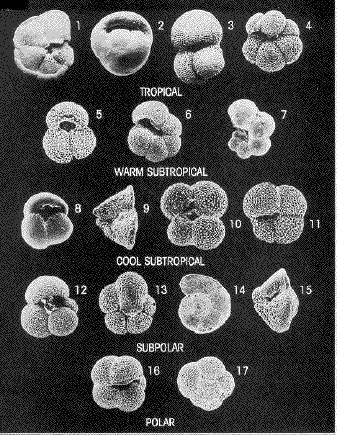
Corals:
Proxies and Archives:
Web resources:
• Proxies: for times when no one was measuring (e.g.,
temperature, precipitation)
• Archives: where we find our proxies
RECORDS of climate: time is 'of the essence'. Records will
have a certain age, as well as a certain time resolution.
• Instrumental records: maximum few centennia (mercury thermometer invented by Fahrenheit, 1714. Fahrenheit temperature scale: 1724
• Historical written records: millennia
• Tree rings: millennia
• Ice cores: hundred thousands of years (450,000 years)
• Coral reefs: hundred thousands of years
• Lake sediments: hundred thousands-millions
• Deep ocean sediments: ~170 millions of years
• Sediments on land/shallow ocean: billions of years
Written records (indirect descriptions of
climate):
• Harvest records (kings' lists of tribute); years of good/bad harvest tell about weather
• Descriptions of agriculture (Domesday Book: grape culture in England)
• Description of date of first flowering of cherry blossoms, Imperial Palace, Kyoto (since ~ 800 AD)
• Records of date of closure of ports by sea ice, Iceland (since 900 AD).
• Annual rings (count age)
• How well was tree growing? Good and bad years (temperature, precipitation)
• Counts annual layers, know age
• Measure gases in bubbles in ice: concentration CO2, CH4
• Isotopes of H, O: temperature; dust
Records from Antarctica, Greenland, mountain ice cores. Records from Antarctica (Vostok ice core) go back furthest (420,000 years); document low atmospheric CO2 levels during ice ages. CO2 levels are measured in bubbles of air trapped in the ice (fossil air), the temperature is reconstructed from the Deuterium and Oxygen18 content of the ice (see next lecture).
Click here for more figures from ice cores (PAGES program), here for more figues of gases in 'fossil air' in ice cores.
• Grow in annual layers (count to get age)
• Organism: good years, bad years
• Measure trace element: temperature
Note that corals are combinations of animals (related to jellyfish)
and unicellular, symbiotic algae. Corals derive most nutrients from
algae, hence growth depends upon light availability.
• Layered sediments: seasonal (layers are called varves)
• Biological or geochemical data: temperature, lake productivity
Various organisms: ecosystems, temperature, seasonality, pH, pollution
Lakes are ephemeral in a geological sense; lake environments can also be studied in ancient lakes, however (e.g., 200 million year old Connecticut lakes).
Sediments in open, deep ocean: 'oozes': consist mainly of skeletons
of unicellular eukaryotic organisms.
Example: Planktonic foraminifera: zoned with temperature

Reconstruction of sea surface temperatures, last ice age: using planktic foraminiferal transfer function. (Last Glacial Maximum)
Land sediments: How do we know whether glaciers occurred somewhere in
the past?
Signs of ice:
• Moraines: ridges of sediment consisting of a mixture of fine clayey material (ground-up rocks), sand, and gravel and boulders (till)
• Erratic blocks
• Grooved rocks
• In marine sediment: ice-rafted material
Use fossils:
Type of fossils give qualitative information on climate (e.g., palm trees, crocodiles; temperature not below freezing in winter).